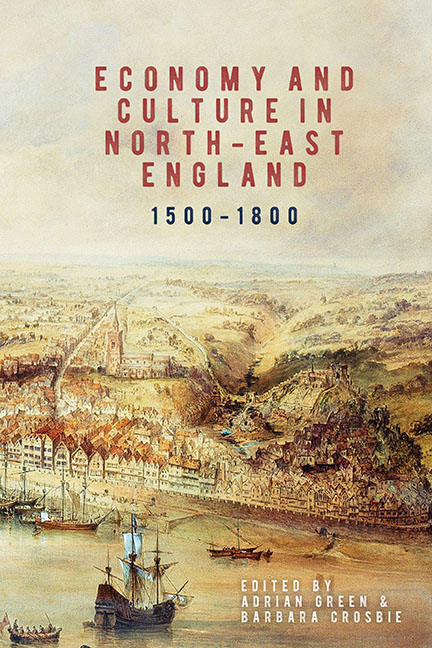Book contents
- Frontmatter
- Contents
- List of Maps, Figures and Tables
- Preface
- Contributors
- Foreword
- List of Abbreviations
- Map
- Introduction: ‘Beyond Coal and Class’: Economy and Culture in North-East England, 1500–1800
- 1 Church Leaseholders on Durham Cathedral's Estate, 1540–1640: The Rise of a Rural Elite?
- 2 Durham Ox: Commercial Agriculture in North-East England, 1600–1800
- 3 Fluctuating Fortunes: The Bowes Family and Lead Mining Concessions, 1550–1720
- 4 Material Matters: Improving Berwick-upon-Tweed's Urban Environment, 1551–1603
- 5 Work before Play: The Occupational Structure of Newcastle upon Tyne, 1600–1710
- 6 Maintaining Moral Integrity: The Cultural and Economic Relationships of Quakers in North-East England, 1653–1700
- 7 Shipping on the Tyne: The Growth and Diversification of Seaborne Trade in the Eighteenth Century
- 8 From Carboniferous Capitalism to Complementary Commerce: Coastal and Overland Trade between North-East England and Scotland, 1580–1750
- 9 Provincial Purveyors of Culture: The Print Trade in Eighteenth- Century Newcastle upon Tyne
- 10 Parish, River, Region and Nation: Networks of Power in Eighteenth-Century Wearside
- Bibliography
- Index
- Volumes Already Published
5 - Work before Play: The Occupational Structure of Newcastle upon Tyne, 1600–1710
Published online by Cambridge University Press: 13 July 2019
- Frontmatter
- Contents
- List of Maps, Figures and Tables
- Preface
- Contributors
- Foreword
- List of Abbreviations
- Map
- Introduction: ‘Beyond Coal and Class’: Economy and Culture in North-East England, 1500–1800
- 1 Church Leaseholders on Durham Cathedral's Estate, 1540–1640: The Rise of a Rural Elite?
- 2 Durham Ox: Commercial Agriculture in North-East England, 1600–1800
- 3 Fluctuating Fortunes: The Bowes Family and Lead Mining Concessions, 1550–1720
- 4 Material Matters: Improving Berwick-upon-Tweed's Urban Environment, 1551–1603
- 5 Work before Play: The Occupational Structure of Newcastle upon Tyne, 1600–1710
- 6 Maintaining Moral Integrity: The Cultural and Economic Relationships of Quakers in North-East England, 1653–1700
- 7 Shipping on the Tyne: The Growth and Diversification of Seaborne Trade in the Eighteenth Century
- 8 From Carboniferous Capitalism to Complementary Commerce: Coastal and Overland Trade between North-East England and Scotland, 1580–1750
- 9 Provincial Purveyors of Culture: The Print Trade in Eighteenth- Century Newcastle upon Tyne
- 10 Parish, River, Region and Nation: Networks of Power in Eighteenth-Century Wearside
- Bibliography
- Index
- Volumes Already Published
Summary
Seventeenth-century Newcastle upon Tyne is difficult to visualise today. The fashionable shops and handsome merchant houses along Pilgrim Street have mostly been demolished. The guildhall and merchants’ mansions on the Sandhill, the old social core of the city, are dwarfed by the heavy industrial achievement of the iron-framed Tyne Bridge and what survives of the town wall is now more associated with the Chinatown created by Hong Kong émigrés in the late twentieth century. But in the sixteenth and early seventeenth centuries, a time of relative stagnation in many English and European towns, Newcastle probably saw the most economic and social change, and resultant population growth, of any English urban place outside London. The river bustled with trade of all types being moved by men in single-sailed keel boats, and the stone-built Tyne Bridge groaned under the shops and traffic that crossed from one side to the other. The town, which continued to sprawl outside its thirteenth-century walls in all directions, grew at an astonishing rate. Such vitality was apt to draw breathless hyperbole from even the most weathered early modern travellers, the social commentators of the day. In 1635 the Cheshire gentleman Sir William Brereton put Newcastle ‘beyond all compare the fairest and riches towne in England’, on a par with London and Bristol ‘for wealth and building[s]’. When Celia Fiennes trotted into the city from Hexham, on the ‘hottest day I met with’ in July 1698, she smelled ‘the sulphur of [coal]’, which ‘taints the air’, but she saw ‘a noble town’ that ‘most resembles London of any place in England, its buildings lofty and large … the streets are very broad and handsome’. Daniel Defoe, a Tyneside resident in the 1710s, also noted the industrial sights and smells, but suggested that people and commerce trumped any aesthetic consideration. He praised the town as ‘spacious, extended, [and] infinitely populous’, and remarked that its unpleasant qualities were ‘made amends abundantly by the goodness of the river, which … makes it a place of very great business’.
That contemporary travellers were so impressed makes it all the more surprising that our knowledge of Newcastle's expansion in this period remains patchy. The town has attracted important micro-studies of politics in the ‘Puritan Revolution’ and latterly of the urban experience of plague.
- Type
- Chapter
- Information
- Economy and Culture in North-East England, 1500–1800 , pp. 115 - 135Publisher: Boydell & BrewerPrint publication year: 2018
- 1
- Cited by



